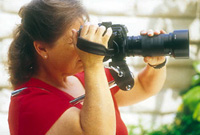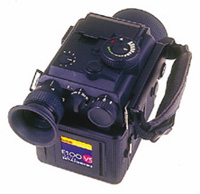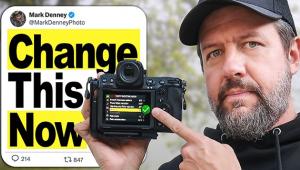Get A Grip
Camera Comfort Is Not Just A Luxury
Most novices buying their first "serious" SLR tend to pay too much attention to the number of features, but too little to camera "ergonomics" (how a camera fits your hands and face while looking through the viewfinder). Today's top of the line, "pro" SLRs feature rubbery, molded contours designed to help support and balance the bulky, heavy beasts. By fitting your hand as if you had grasped the camera while it was in a pliable state, you gain secure control, rather than having to maintain a constant death-grip just to avoid dropping it. The less effort your hands have to expend on hanging on to the camera, the more sensitivity and feel is available to achieve effective and intuitive operation of the controls. This "molded" approach can be great, but only if your hands are close in size and character to the ones that served as models for the camera's design. If yours are significantly larger or smaller, or if your fingers are longer, shorter, thinner, or thicker, the camera can be less comfortable in use than a camera body with simple, "flat" contours. My fingers, for instance, are longish, and my fingertips frequently "bottom-out" uncomfortably against the body when wrapped around the typical right-hand integral grip. Another problem with some cameras with this style of grip, both 35mm and medium format, is insufficient space between the grip and the lens/mirror box housing. If you have thick fingers, or wear gloves for cold weather photography, it can be difficult or impossible to jam your fingertips into this narrow, inflexible slot. |
|||
Grip Evolution Grip Classics Before the current spate of integral, body-molded grips, the word "grip" relative to cameras would most likely bring to mind a pistol grip. This type of grip has been around for a half century or more. Nearly all pistol grips provide a secure hand hold, usually with a wrist strap as a safety net, and some means of releasing the shutter via a trigger or cable release, either mechanical or electric. Factors in their favor include very reasonable cost, plus easy adaptability to varying hand sizes, at least with the minimally ergonomic models. How well a pistol grip balances the camera load depends on the length/weight of the lens in use, as well as the camera's eyepiece location and whether you are left-eyed or right-eyed. If buying a generic grip, make sure your camera has a centered tripod socket; a socket located at the extreme left or right of the camera's bottom plate results in a very off-balance load that is hard to hold steady, and could result in camera damage when coupled with heavy lenses. Some such cameras can be fitted with an accessory bottom plate adapter that provides a centered socket, usually touted as being for copy stand use. |
|||
The super-ergonomically designed pistol grip for my Rollei TLR is one of the three best grips I've ever experienced (the other two are the Linhof grip and the left-side Hasselblad grip). It is both rotated to the left and canted to the right, meeting your right hand perfectly when held close-in to your body. Long lens balance in conjunction with a pistol grip can often benefit from the addition of a shoulder brace. Some still cameras employ a hand strap (not to be confused with a wrist strap) as a gripping aid, serving to keep your hand solidly positioned over the controls, as well as offering security benefits. Hand straps are common components of camcorders. Advantages include minimal cost, with near zero weight and bulk penalties. Another simple grip is what I call a "finger hold" or "fingertip assist" grip. Some current, mid-range cameras feature these integrally on the right-front edge (as seen from the back) of the body. Olympus has a good accessory grip of this type for some of their OM-series SLRs, as does Leica for their M-series rangefinders. I find these grips to be somewhat irrelevant with the camera held in horizontal format, but quite helpful for verticals, if the camera's eyepiece location and your camera eye (left or right) result in you shooting verticals with that (right) end of the camera held upward.
|
|||
Side-Mount Options The most basic models are simply handles with some means of triggering the shutter release. Bronica (and, more recently, others) developed the Speed Grip for their 6x4.5cm ETR-series cameras, featuring a 35mm-style thumb-wind lever for advancing the film in lieu of the usual cranking operation. Most medium format SLR makers now offer either cameras with built-in grips that house film drive motors and/or batteries, or add-on accessory grips that upgrade a model to the same state. An accessory hot shoe resides atop several of these units. The majority of these grips are most comfortable in conjunction with either waist-level finders or 30 or 45 angled prism finders; eye-level, 90 prisms work better with pistol grips. Large Format Grips? |
|||
Gripping Tales For earlier cameras, you should have no problem finding a variety of after-market grips. Most large camera stores will carry at least a few grips; those with a substantial pro clientele will also likely stock a variety of grip/flash bracket units, many of which allow flipping the flash position back and forth between horizontal and vertical compositions. |
|||
But whatever grip strikes your fancy, be sure to try before you buy. As I indicated earlier, size matters, and it's imperative that your hand mates comfortably with the grip. With generic after-market units, you need to also make sure that the grip's size and design are appropriate for your particular camera; some elaborate side grips, for instance, can be a case of overpowering overkill when paired with a compact 35mm SLR. If all else fails, a machine shop can help you adapt a grip, as I did with the Linhof grip on my Rollei 3003. But if you take your time and do your homework thoroughly, you'll eventually find that perfect grip that feels so good that you'll wonder how you ever got along without it! Camera Grip Pointers
|
|||
|













































